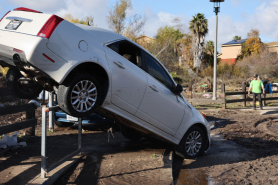

A recent video posted to social media is an excellent reminder to check your running shoes before putting them on, especially if you left them outside. A snake wrangler in California shared a clip showing a small venomous snake hiding in a pair of sneakers.
Check out the video:
The video, captioned “Don’t Leave Shoes Outdoors,” shows snake wrangler Bruce Ireland arriving at a home after being called in to handle a snake. After a quick peek inside a shoe, a small snake lashes out multiple times.
The comments include plenty of people who say they would throw the shoes out: “I’ll be buying a new pair anyway.”
Others who are used to seeing snakes around are more confident, “As someone who lived in Australia since birth, I still don’t understand why anyone would leave their shoes out.”
“Shoes left outside are never a good idea,” wrote Ireland. “Especially in areas with venomous snakes.”
Ireland, who handles wild animals like snakes professionally, is located in Southern California, but this snake safety policy is true for wherever snakes may call home.
The animal likes to find small, dark places to ball up. Experts say being in a place like a shoe makes snakes feel safe. Hopefully, this video will make people feel unsafe and double-check their sneakers before putting them on for a run.
Treating a Snake Bite
So, what do you do you do if a snake bites you?
Unfortunately, it can happen. Sometimes, a lack of attention leads to a snake biting a person or pet. Health officials say the first thing you need to do is get away from the animal. Stay calm and sit or lie down to keep the bite in a comfortable position. Before swelling starts, remove any jewelry, watches, or tight clothing. Contact medical help as soon as possible.
The Mayo Clinic says to avoid these common misconceptions:
- Don’t use a tourniquet or apply ice.
- Don’t cut the bite or try to remove the venom.
- Don’t drink caffeine or alcohol.
- Don’t take pain-relieving medicine, such as aspirin, ibuprofen (Advil, Motrin IB, others) or naproxen sodium (Aleve). Doing so can increase your risk of bleeding.
- Don’t try to catch or trap the snake. Try to remember its color and shape so that you can describe it. If possible, take a picture of the snake from a safe distance. Knowing what kind of snake bit you can help with treatment.
About 20% of snakes in the U.S. can inject poison when they bite.









